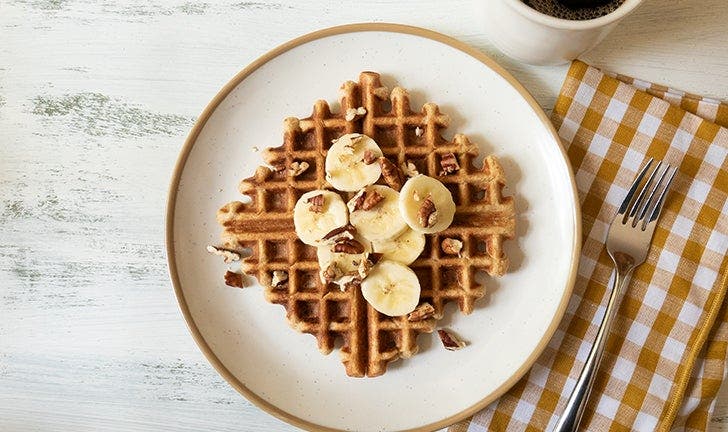Celebrate National Waffle Day!


Fast facts about the history of waffles
- While waffles might seem like a relatively new addition to the breakfast table, we actually have the ancient Greeks to thank for developing an early prototype for the waffles we know and love today. Many thousands of years ago, the Greeks would make obelios, a thin cake made from grain flour and water that was cooked between two metal plates.
- Throughout the medieval period, the Catholic church began making oublies, a wafer-like cake cooked between two plates that, even today, shares many similarities with communion wafers still used today. As time passed, the batter for these wafers was expanded to include ingredients such as honey, cream, and spices.
- The invention of the waffle iron is thought to have occurred during the 15th century, with the introduction of rectangular irons and the familiar grid pattern still currently used for waffle makers.
- The first English-language usage of the word “waffle” appeared in a 1725 cookbook, called Court Cookery, and featured a recipe for waffles based on Dutch, German, and Belgian waffle-making methods.
- In 1953 the familiar Eggo waffle was created for mass production. Interestingly, the original name for the brand was “Froffles,” a combination of the words “frozen” and “waffle.” Consumers thought the waffles had a distinctly eggy flavour and gave them the nickname “Eggos” — eventually the name was permanently changed to the one we know today.
- National Waffle Day falls on August 24th and commemorates the first ever waffle iron patent in the United States. The patent was filed by Cornelius Swarthout in Troy, New York on August 24, 1869.
Types of waffles
Belgian waffle: Despite the name, these crispy-on-the-outside, fluffy-on-the-inside waffles are actually an American invention. Belgian waffle recipes tend to use baking powder as a leavener, instead of traditional yeast.
Brussels waffle: These waffles share taste, texture, and appearance with Belgian waffles, but are made with yeast as a leavener. Both Brussels and Belgian waffles are delicious when served with fresh fruit and powdered sugar.
American waffles: American-style waffles are similar to Belgian waffles, but tend to use baking powder as a leavener, resulting in thinner waffles with small holes. This type of waffle is often served with savoury toppings (such as chicken and gravy), but is also well-suited to sweet toppings.
Toaster waffles: Toaster waffles are usually commercially prepared, from the frozen food aisle. Toaster waffles can be topped with a wide variety of sweet and savoury ingredients, making them a handy convenience item to keep in the freezer. Look for whole grain, plain versions and top with your favourite healthy sides.
Liege waffles: A dessert waffle if there ever was one, Liege waffles are sweet and dense, with chunks of granulated sugar incorporated into the batter.
Tips for making waffles at home
- Preheating the waffle maker before pouring the batter is important for two reasons: the correct temperature creates a crispy, golden exterior while ensuring the inside of the waffle stays light and fluffy. Older waffle irons will take about 10 minutes to heat up, while new models typically have a light to indicate when the appliance is hot enough.
- Follow the recipe and cooking times exactly as written, this is especially true when yeast is listed as an ingredient as it may need time to proof in advance. The exception to this rule is if you have an older waffle iron with an unreliable heating mechanism, in which case increase or decrease the cooking time as needed.
- For the sake of even cooking and neat presentation, pour in slightly less batter than the recipe calls for, not more.
- When it comes to making homemade waffles, there’s nothing more disappointing than a waffle that sticks and tears apart. Always apply a thin coating of cooking spray before adding the batter, even if you’re working with a non-stick waffle iron.
Waffles on the sweeter side
If you like to start the day with something sweet, these waffle recipes are a great place to begin. For recipes using bananas in the batter, unless otherwise indicated, use overripe, soft fruit — the same kind used for making banana bread. The fruit-based toppings can be altered to suit what’s seasonally available, simply sub in the same amounts with the fruit of your choice.
Try these slightly sweet waffle recipes:
Waffles with a savoury kick
When you have a carton of eggs and frozen waffles in the freezer you’re never more than 10 minutes away from a satisfying meal. In addition to the suggestions below, try topping savoury waffles with unexpected sources of protein such as crispy tofu, oven roasted chicken, halloumi (or any other grilling cheese), pulled pork, or hummus. Condiments such as hot sauce, soy sauce, salsa, and kimchi add plenty of flavour without extra effort.
















